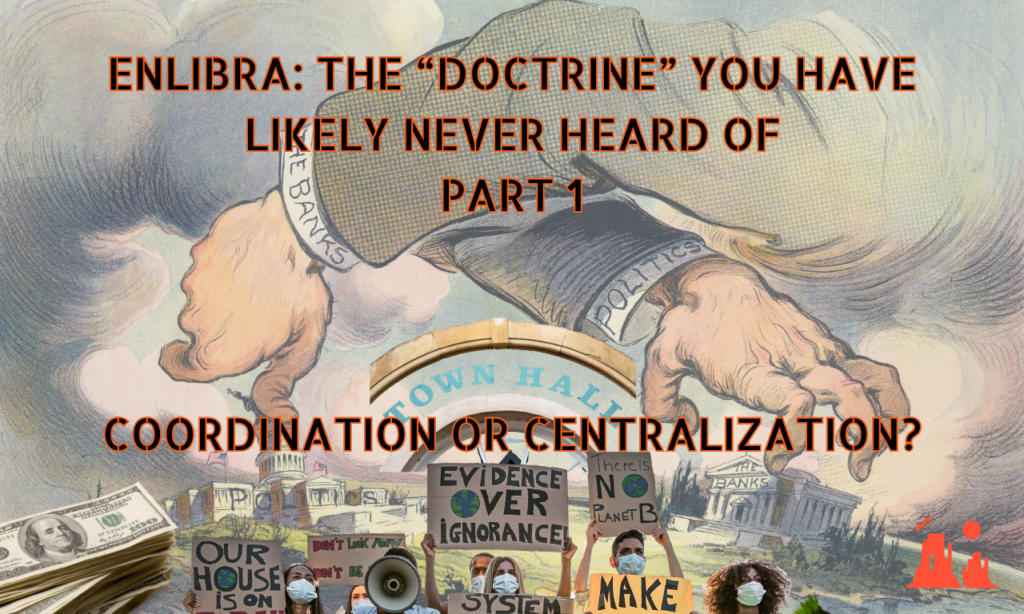If you have read some of our more recent articles, you are aware that Utah, specifically former governor Mike Leavitt and all that have followed, helped push some very bad programs out to not just Utah but the country and in some cases the world.
House Keeping:
Some articles you should read to fully grasp what’s happened are:
https://utahfreedomcoalition.org/why-49-other-states-should-not-follow-the-utah-way/
And a video we feel is cirtical to watch, so you can fully grasp what Enlibra is part of.
Setting the stage in the 1990’s
1993 – Mike Leavitt and the governors of Oregon and Colorado start discussing “SmartUTAH” which turns into Smart States. See the Defending Utah article we posted above for more information.
1995- Coalition for Utah’s Future along with the legislature and wishes of the governor (Mike Leavitt) create a special committee to research growth issues and make recommendations: the Quality Growth Steering Committee begins. This group was made up of business leaders, a representative from the governor’s office of planning and budget, the president of Utah’s largest real-estate developer, several state legislators and urban planning advocates, and several reps. from local governments. (Note who is missing from this discussion.)
They created QGET (Quality Growth Efficiency Tool) which partners with Envision Utah. Former governor Jon Huntsman Jr. led the final development and part of implementation of “Quality Growth Strategy.” The Quality Growth Act was put in place in 1999 (HB119).
1995- Mike Leavitt decided to create a sub-cabinet group that was comprised of UDOT (Utah department of transportation), DEQ (department of environmental quality), DCED (Utah department of community and economic development), and the Dept. of Natural Resources. (Again, please note who is missing.)
1995: Mike Leavitt hosts a high-profile summit to discuss growth-related issues, encouraging participation from Utah’s legislative leadership as well as local government leaders. The event focused mainly on transportation issues and open space preservation (Utah Open Lands since 1990s). It is believed to have influenced the passage of legislation for open space preservation and for funding QGET (Quality Growth Efficiency Tool). Hint Utah- check out the LeRay McAllister fund. The effort was launched under the name of “The Utah Quality Growth Public/Private Partnership” –which later evolved into Envision Utah.
Source: History of Envision Utah EPA
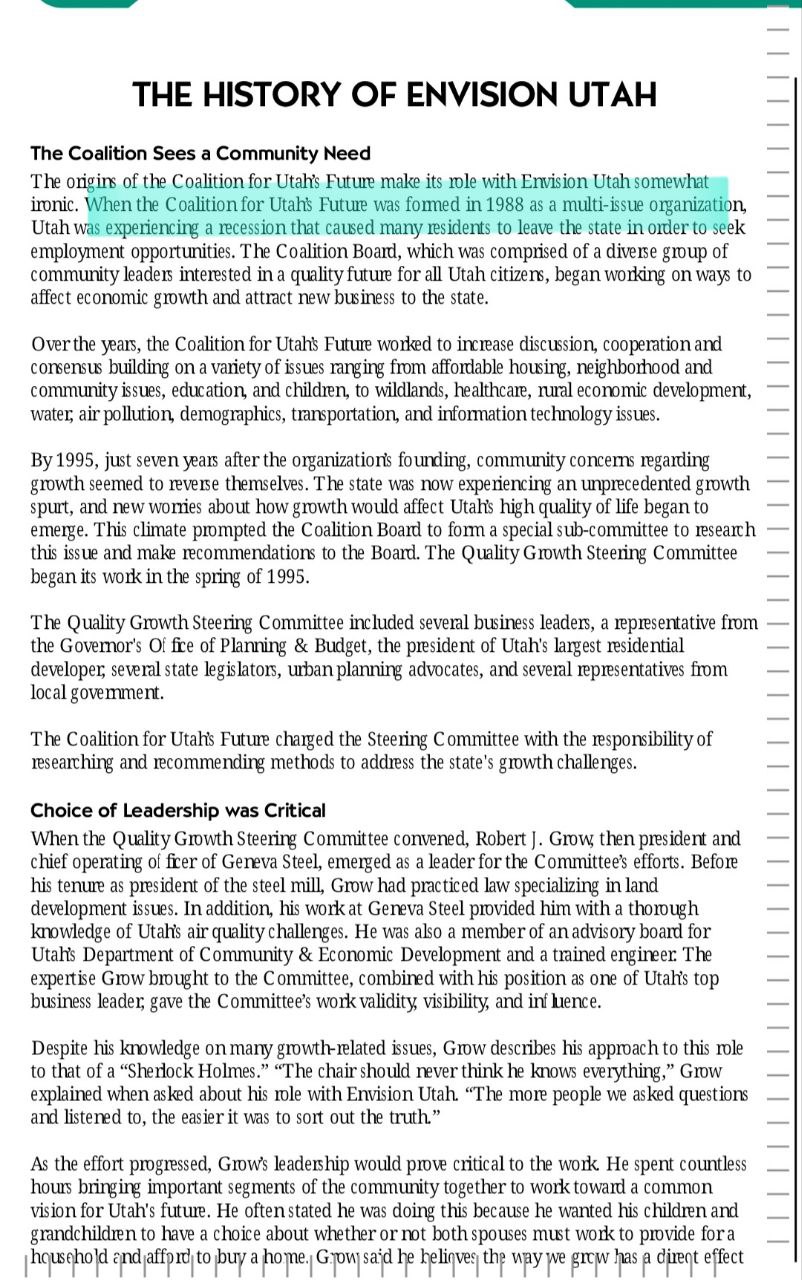
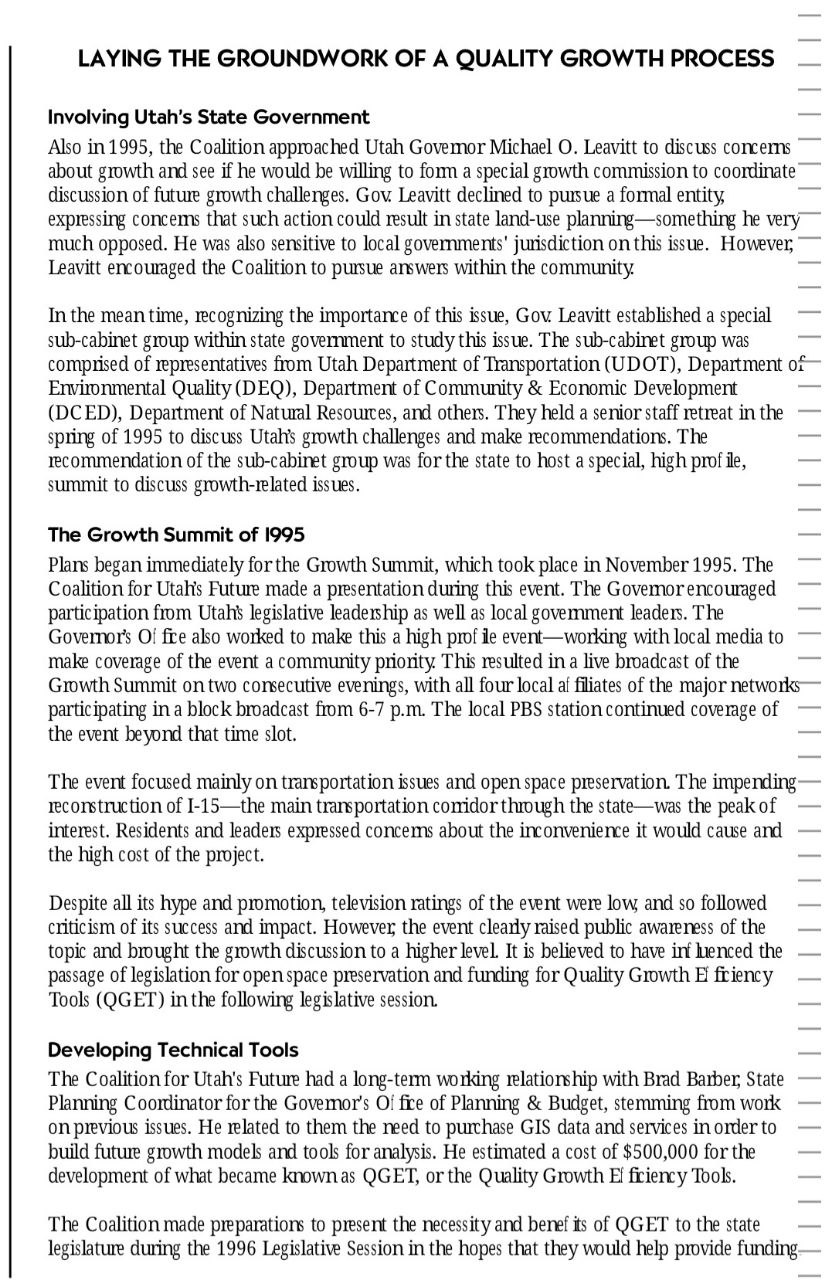
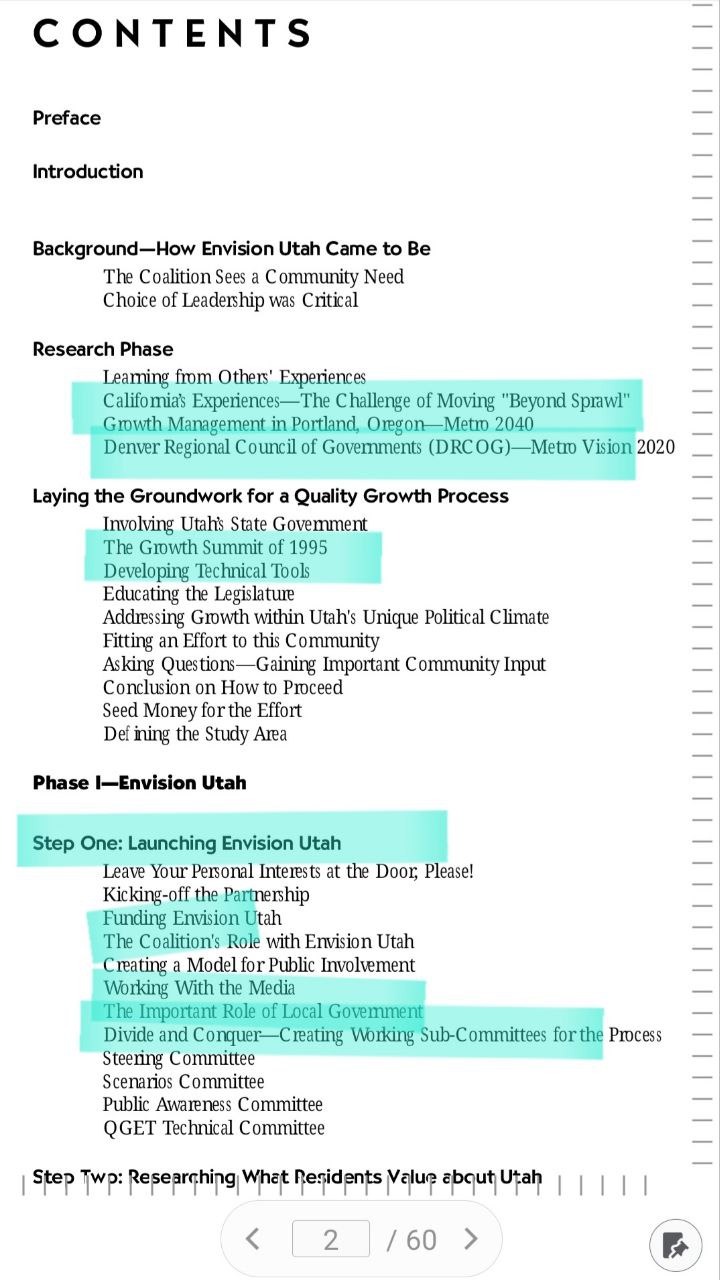
Source: History of Enlibra EPA
In 2022 they repealed the commission and replaced it with the new land Conservation Board. We are still researching if this is good or bad. Often things look one way but are another.
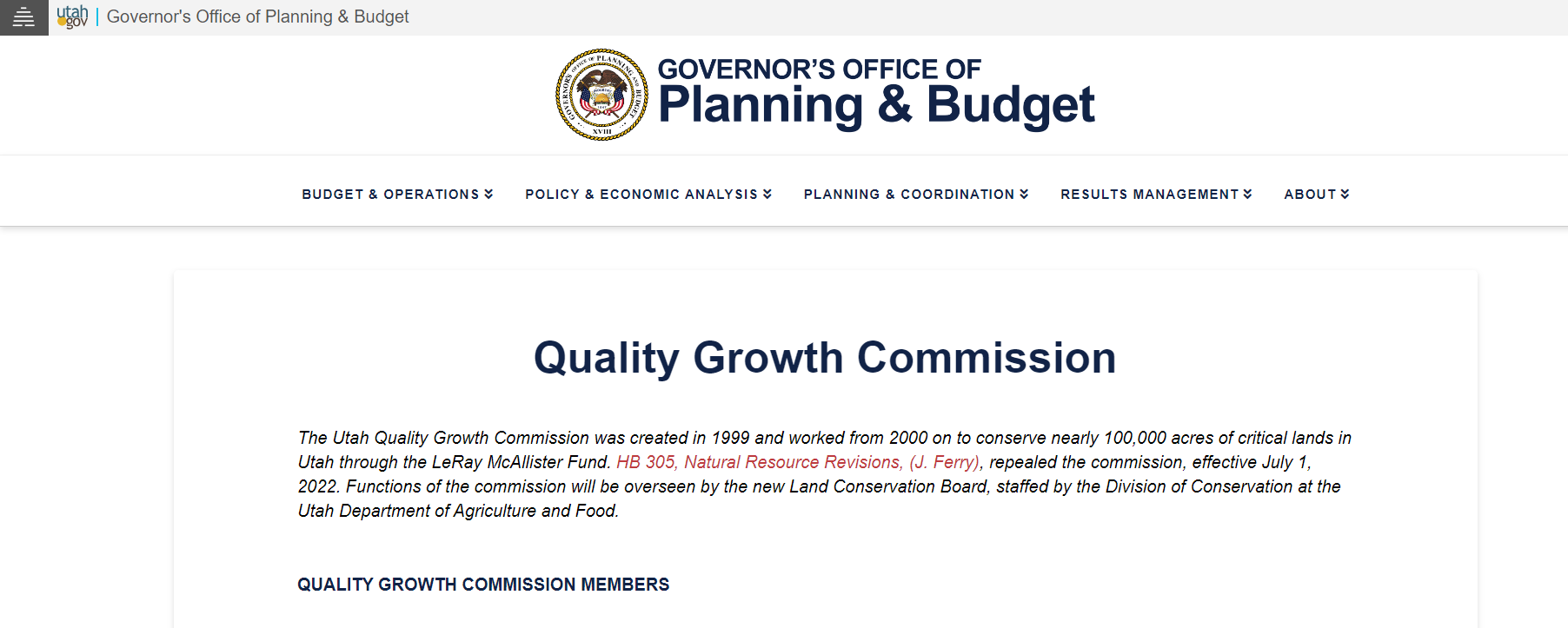
Source: https://gopb.utah.gov/quality-growth-commission/
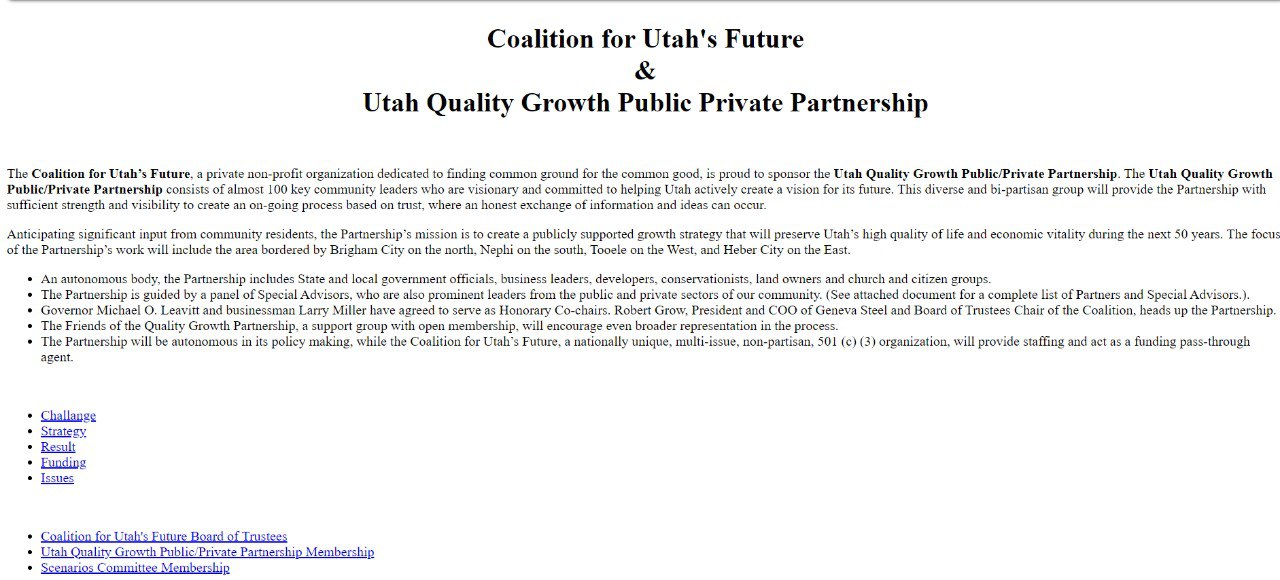
Before they realized the public was catching on to the “green agenda” being used to take control over things the government has no business in (note the goals of the Quality Growth Strategy) they were far more honest with their agenda. It seems they change names, commissions, businesses, etc, in order to make it harder for the public to track.
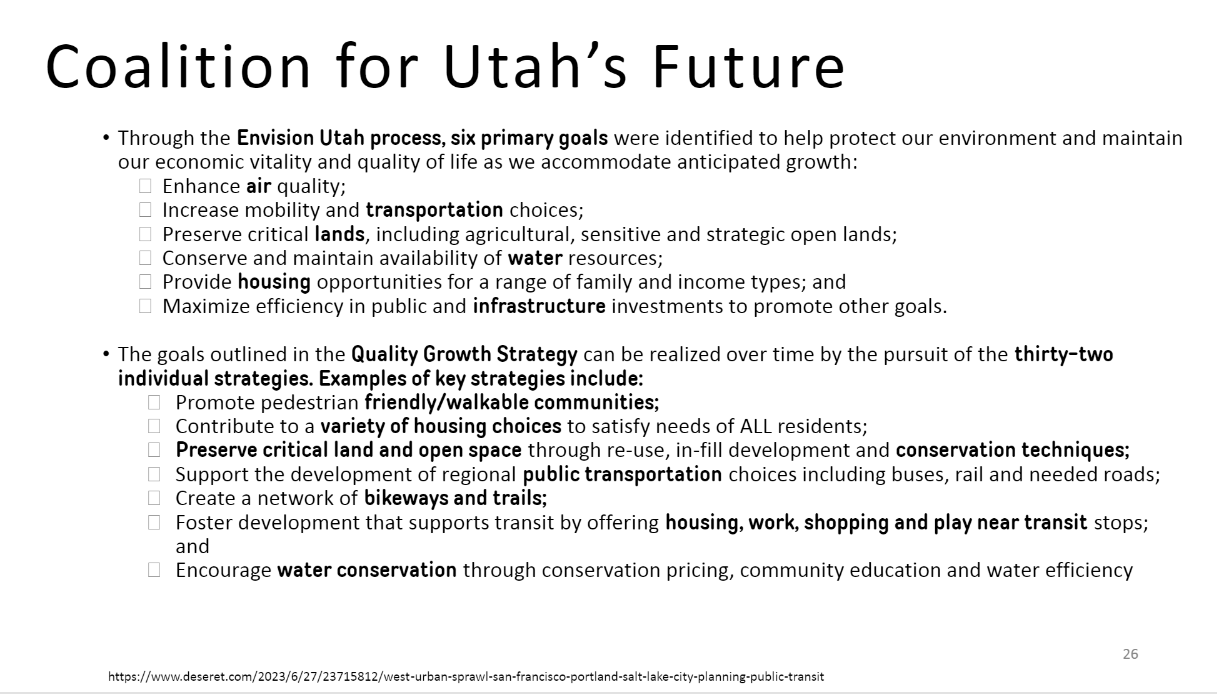
Do we notice any striking statements here? This is not recent, this is twenty years old. They were talking about “walkable” cities back then. High-density housing, taking our land, trails, 15 min cities… and the big one, water conservation.
So how does this tie in with Enlibra?
It starts with Oquirrh Institute
The BIG Think Tank
2002: Public launch of Oquirrh Institute by Mike Leavitt. (However, some documentation say as early as 1953; we think it’s likely the school they are referencing.) Launched in Salt Lake City, Utah, during the 2002 Olympic Winter Games. The Institute celebrated its one-year anniversary at the annual Board of Trustees meeting held at the Alta Club in Salt Lake City, February 2003.
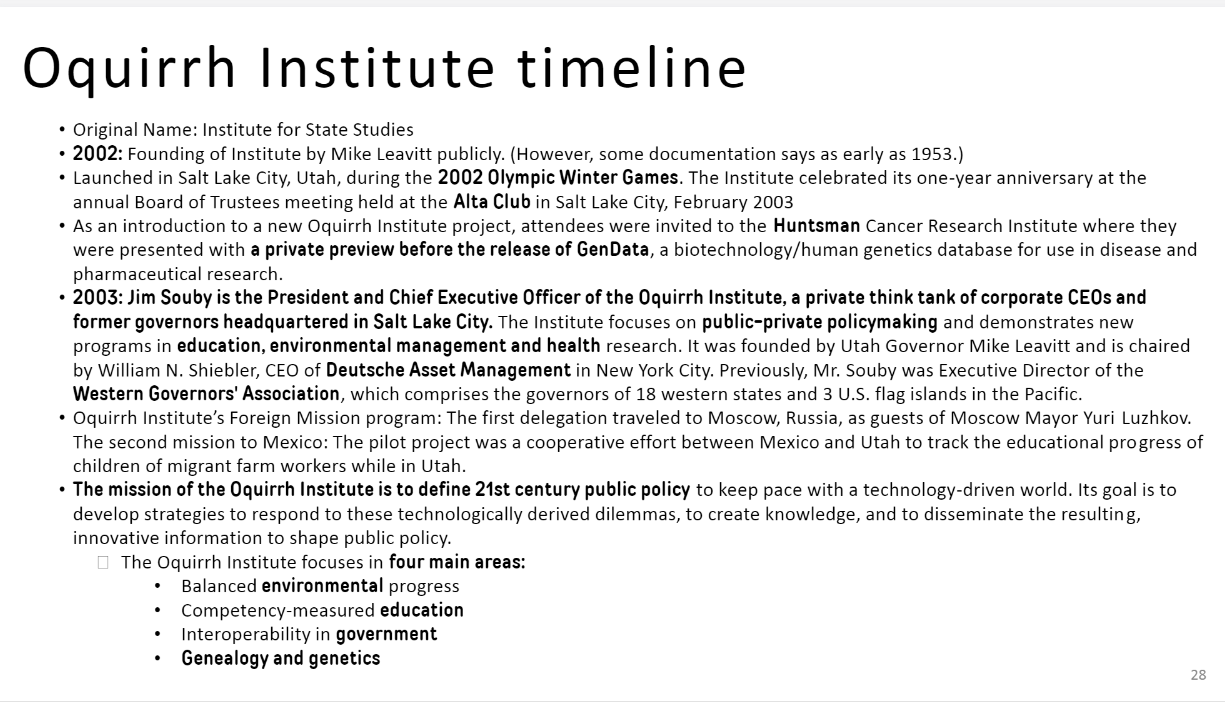
Oquirrh Institute- as we have addressed in other blogs, and Defending Utah has addressed in some of theirs, has 4 key areas. Those areas are quite concerning considering where we’ve ended up. See below:
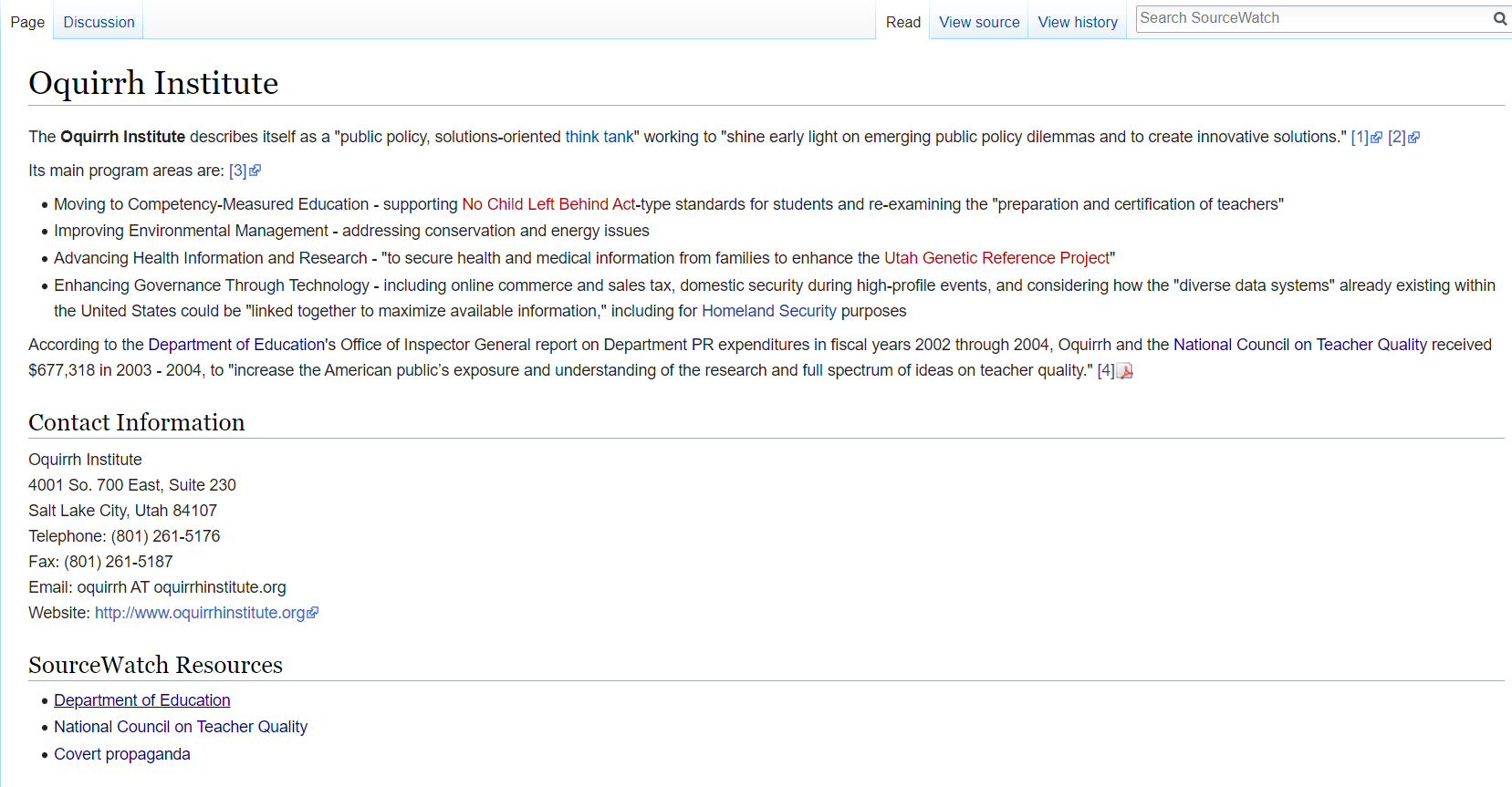
Source: https://www.sourcewatch.org/index.php/Oquirrh_Institute
Oquirrh and The Center for Environmental Management’s first project—the Enlibra Toolkit
Oquirrh Institute Funding for the February meeting, as well as other CCME projects, was provided by the Gates Foundation
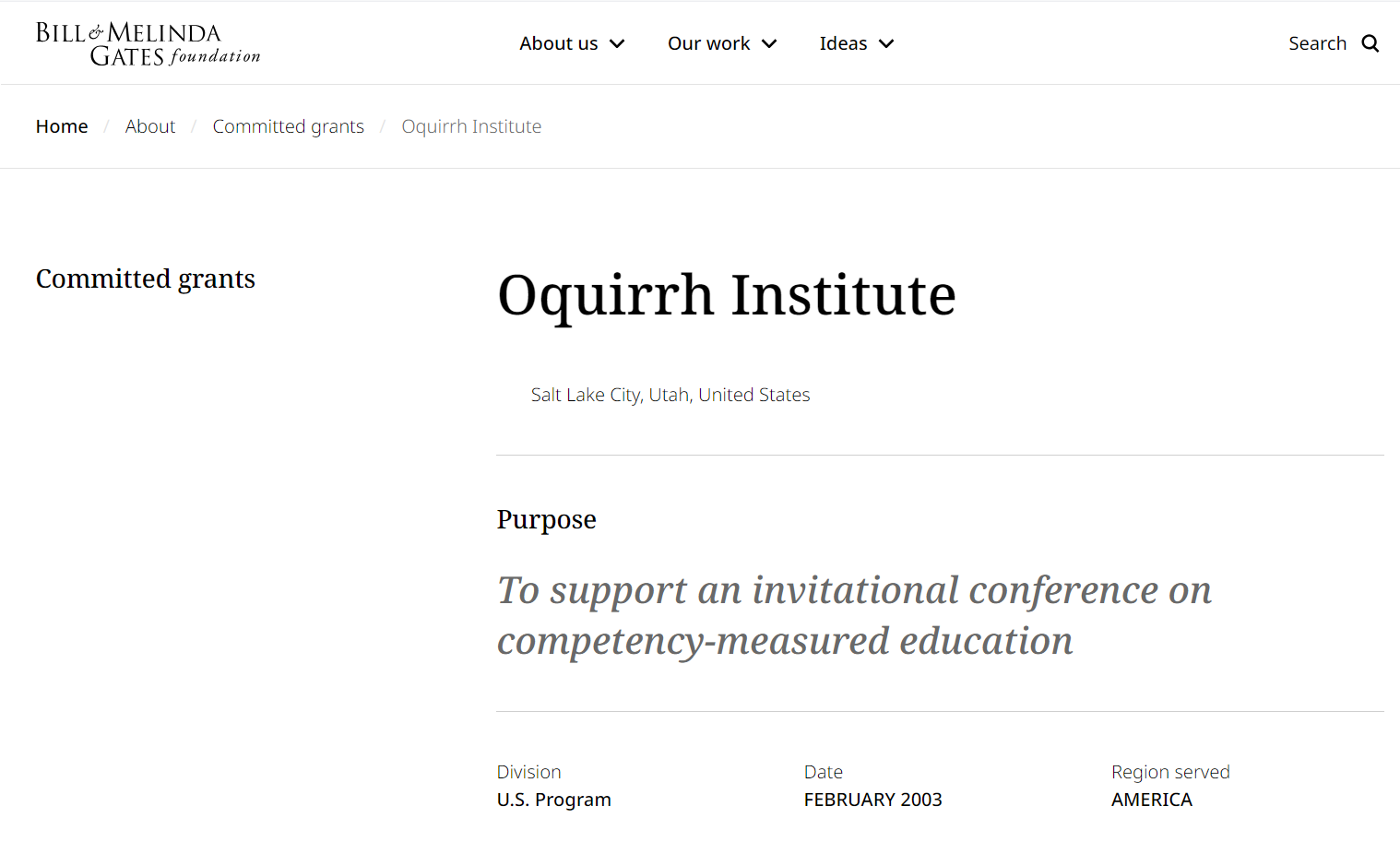
https://www.gatesfoundation.org/about/committed-grants/2003/02/opp27072
Oquirrh hosts an event in 2004: Public safety agency leaders from across the United States, as well as Olympic security executives for the Turin and Athens Olympics, share information gathered in Salt Lake City in October 2002 to discuss and develop security strategies at the first summit hosted by the Center for Olympic and Major Event Security. This ties in with our earlier blog.
Oquirrh Institute changes its name to Park City Center for Public Policy at some point.
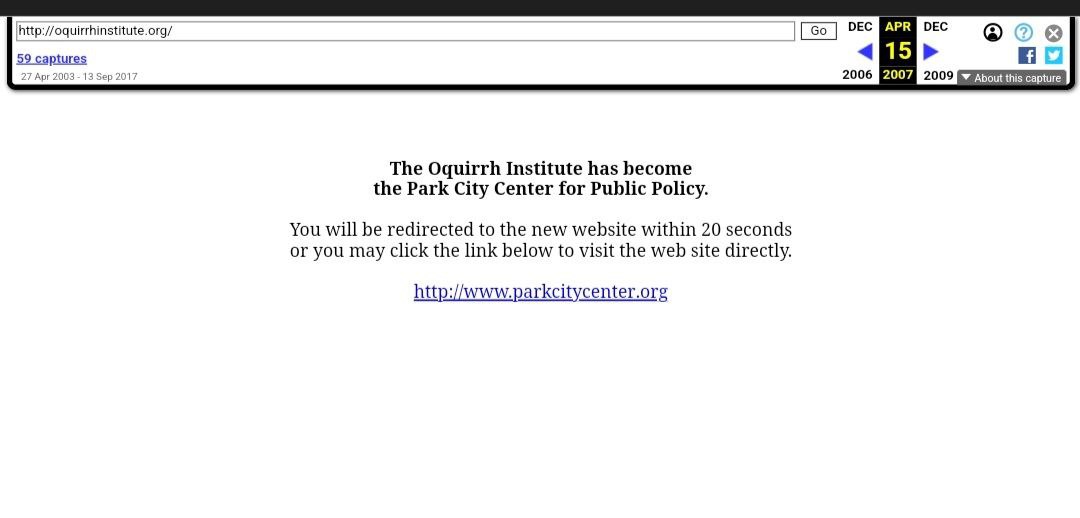
What did it become afterwards?
All signs point to Mike Leavitt’s official bipartisan policy center, located in Washington D.C.
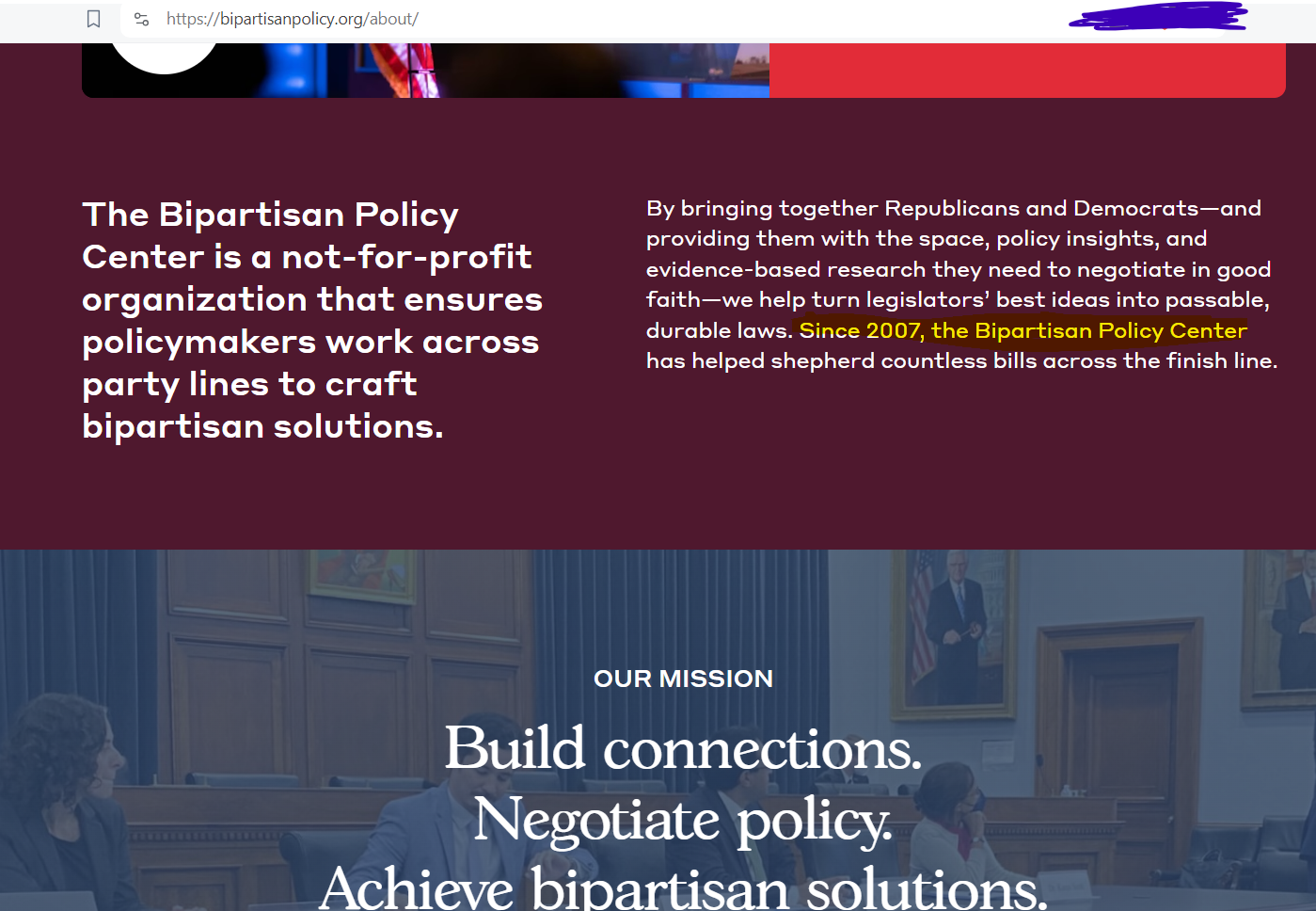
The website itself appears to have been almost an orphan or landing page for a while.
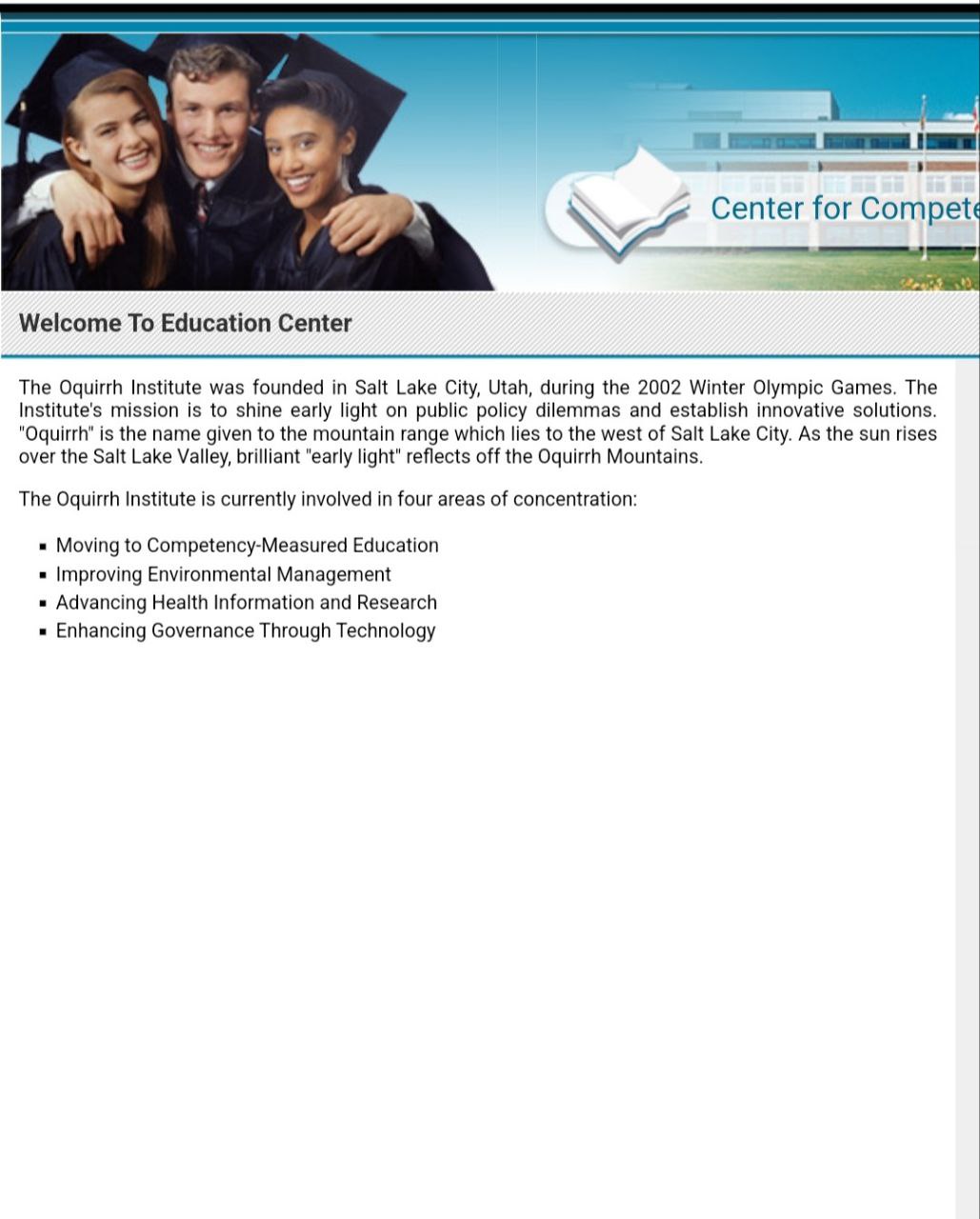
But we’re pretty sure it morphed into a few separate think tanks.
Oquirrh ended up at SUU after failing it’s Park City move.
Plus Leavitt went onto help found the Bipartisan Policy Center and he co-chairs the BIG one in Utah- Kem. C. Gardner (created in 2015) oddly enough.
Now onto Enlibra
Mike Leavitt was appointed to head of the EPA by George Bush Jr in 2003.
Timeline for Enlibra is often hinted at 2002/2003. Much like Envision Utah it appears it’s earlier than that.
“At the “Environmental Summit on the West” in late 1998, the Western Governor’s Association espoused a new doctrine called “Enlibra”, meaning “moving toward balance”
(Greenwire, 1998). The doctrine, developed by Governors Kitzhaber of Oregon and Leavitt of Utah, promotes “collaboration [and] local decision making” (Brinckman in Greenwire, 1998).”
And another source:
“CBNRM and ecosystem management are also supported by state level policy through agreements like the Enlibra doctrine which was signed in 1998 by the Western Governor’s Association to promote ecosystem management in forests (Malone 2000). Oregon was a signatory and has been active in creating policies, legislation, and programs consistent with the Enlibra Doctrine and in support of ecosystem management (Malone 2000). The Oregon Plan for Salmon and Watersheds, legislation, and funding have supported the development of watershed councils to manage riparian/watershed ecosystems on a local level (Malone 2000)”
Source: THE ROLE OF SOCIO-ECONOMIC INDICATORS IN WATERSHED MANAGEMENT HEATHER GUREWITZ
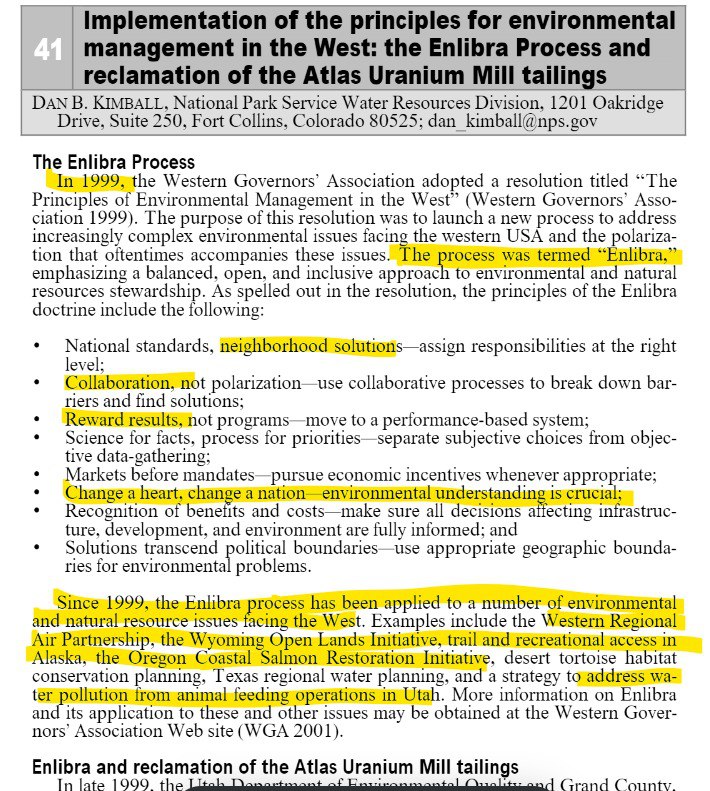
What is Enlibra?
“The Enlibra Toolkit is a comprehensive document designed to assist decision makers as they solve challenging environmental problems.”
Source: THE ROLE OF SOCIO-ECONOMIC INDICATORS IN WATERSHED MANAGEMENT HEATHER GUREWITZ
If you want a funny take here’s a clip from Jon Stewart
https://www.cc.com/video/7x5kvg/the-daily-show-with-jon-stewart-enlibra
Their philosophy is “An environmental philosophy, Enlibra-a word derived from Latin roots that means “to move toward balance.” Mike Leavitt explained that the eight principles of Enlibra form the prism through which he views environmental issues.””
Source- https://www.epa.gov/archive/epa/aboutepa/biography-michael-o-leavitt.html
Project senior fellow Brad Barber describes the Enlibra project process in five phases:
- Development
- Legitimizing the ideas through adoption
- Developing the toolkit
- Education and training
- Certification
Now let’s look at their eight principles:
- National Standards: Neighborhood Solutions Assign responsibilities at the right level: In many instances, it is entirely appropriate for the federal government to establish national environmental standards. However, states, tribes and local governments should have the flexibility to develop their own plans to achieve the national standards, and to provide accountability. Plans that consider localized ecological, economic, social and political factors often enjoy more public support and involvement and therefore can reach national standards more efficiently and effectively. Governments at all levels should reward innovation and support empowerment for any entity that can meet or exceed standards and goals through localor regional plans.
- Collaboration, Not Polarization: Use collaborative processes to break down barriers and find solutions: Environmental issues tend to be highly polarizing, leading to destructive battles that don’t further environmental goals. Goals are best accomplished through balanced, open and inclusive approaches at the ground level, where stakeholders work together to formulate critical issue statements and develop solutions. Collaborative approaches often result in greater satisfaction with outcomes and broader public support at less cost, and better long-term stakeholder involvement. Public and private interests may need to provide resources to ensure these local collaborative processes are transparent, have broad participation and are supported with good technical information.
- Reward Results, Not Programs: Move to a performance-based, instead of process-based, system -A clean and safe environment will best be achieved when government actions are focused on outcomes, not programs and processes, and when innovative approaches to achieving desired outcomes are rewarded. Federal, state and local policies should encourage “outside the box” thinking in the development of strategies to achieve desired outcomes. Solving problems, rather than just complying with programs, should be rewarded.
- Science For Facts, Process for Priorities: Separate subjective choices from objective data gathering: Environmental science is complex, and uncertainties often exist. Competing interests usually point to data supporting their view and ignore or attack conflicting or insufficient information. This results in polarized positions, interferes with reconciling the problems, and may leave stakeholders in denial. Public confidence declines and the stridency of debate increases. A much better approach is to reach agreement on the underlying facts as well as the range of uncertainty surrounding the issue before framing the choices. A public, balanced and inclusive collaborative process should be used, with a range of respected scientists and peer-reviewed science. If agreement on scientific facts cannot be reached, decision-makers must evaluate the differing information and make the difficult policy choices.
- Markets Before Mandates: Pursue economic incentives whenever appropriate. While most individuals, businesses, and institutions want to achieve desired environmental outcomes at the lowest cost to society, many environmental programs include mandates enforced through the threat of legal action, fines and other penalties. While the end result may be environmental protection, this approach is not always efficient or cost-effective. By contrast, market-based approaches and economic incentives often result in more efficiency at less cost, and may lead to less resistance and more rapid compliance. These win-win approaches reward environmental performance, promote economic health, encourage innovation and increase trust among all stakeholders.
- Change a Heart, Change a Nation: Environmental education and understanding are crucial. Governments at all levels can develop policies, programs and procedures to protect the environment. But the success of these policies ultimately depends on the daily choices of citizens. Beginning with the nation’s youth, people need to understand their relationship with the environment. They need to understand the importance of sustaining and enhancing the natural world for themselves and future generations. If we are able to make environmental progress, it will be because citizens understand that a healthy environment is critical to the social and economic health of the nation. Government has a role in educating people about stewardship of natural resources.
- Recognition of Benefits and Costs: Make sure all decisions affecting infrastructure, development and environment are fully informed. Environmental decisions should be guided by an assessment of the true costs and true benefits of different options, including life-cycle costs. These assessments can illustrate the advantages of various methods of achieving common public goals. However, not all benefits and costs are measured in dollars. Non-economic factors, such as equity within and across generations, should also be fully considered in every assessment. Options should consider all social, legal, economic and political factors, while ensuring that neither quantitative nor qualitative factors dominate.
- Solutions Transcend Political Boundaries: Use appropriate geographic boundaries to resolve problems. Many environmental challenges fall within natural geographic locations, but most cross political and agency boundaries. Focusing on the natural boundaries of the problem helps identify the appropriate science, possible markets, cross-border issues, and the full range of affected interests and governments that should participate and facilitate solutions. Voluntary interstate strategies as well as other partnerships are important tools as well.
HNTB Corp., an international architecture, engineering, and planning firm, helped design the toolkit content and layout. Toolkit authors from HNTB and the Center for Environmental Management’s Board of Advisors met in Salt Lake City at the Olympic Reunion Gathering in February 2003 to discuss revisions of draft chapters as well as future plans and potential of the Enlibra Toolkit.
As of early 2003: Organizations currently using the principles of Enlibra included: The Pennsylvania Department of Environmental Protection, Interstate Council on Water Policy, Nevada Division of State Lands, The Environmental Management Commission, and the Department of Environmental and Natural Resources of North Carolina.
2003: Mike Leavitt announces Enlibra use and its principles via the EPA-he was head of the EPA from 2003-2005. “Enlibra is a vision for sound management of our natural assets,” is articulated in the Enlibra Doctrine, an approach to environmental stewardship co-authored by Leavitt and former Governor John Kitzhaber of Oregon.
2004: Changes name of Enlibra to “A Better Way” —which appears to be the results we are living with now.
What are they hiding behind all the pretty language?
Well, this is the framework for the “coordination.” To implement, install, and force the climate agenda. An agenda not based on science or even for the genuine betterment of the planet and the People living on it.
It is instead something far more nefarious.
Enlibra Principles:
- National Standards alone should set off alarm bells. What does “national standard” mean in regard to “environmental” issues? It means federal land grabs and worse. Up to 70% of Utah land is owned by the federal government in one way or another. This is NOT state sovereignty. This is theft. Please note what they say about local input. It’s like a parent talking to a child. You can be allowed to do this and that but ultimately you need to join this agenda. We will give you some options (likely none of which the People would agree to or choose if not coerced or forced into it.) Bonus if you are good little girls and boys, you’ll get a reward. This is NOT how a constitutional republic of free people and sovereign states interact.
- Collaboration– This one can be summed up with the carrot before the stick method. Something Utah LOVES and uses often. They will beat you, sweetly, into submission. You will comply and submit to the borg or we will make it hell for you to do otherwise. We call it the Utah wrap up. It essentially works like this if you “disagree:” first, you will get called in to try and sweet talk you into being “friends” and working together. They may say things like “we really appreciate your view and would love to have you on board,” but they don’t really mean that, unless you comply. Second, if you are still not complying with their agenda, they will call you back in and veiled intimidation, or not so veiled, will take place. This is your second chance to bow out nicely and shut your mouth. Third, they come for you. They will destroy you! This can be political smear, it can be pulling all funding or campaign donations, it can be killing all your bills, it can be done in a variety of nasty ways. That is their “collaboration.” A cartoonist back in the 90’s saw through their smooth talkin’ and drew these:
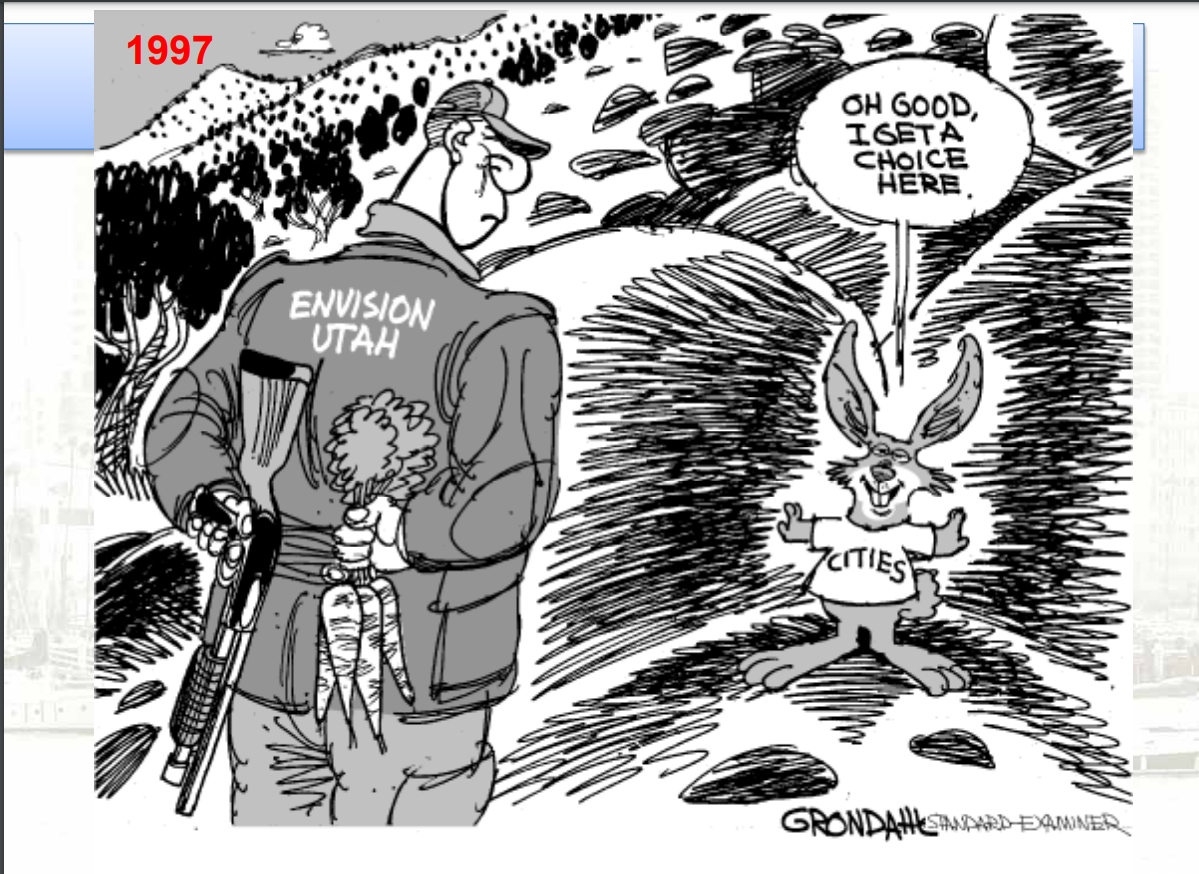

The cartoon shows Envision Utah. Why are we putting that here? Well, Envision Utah and Enlibra aren’t much different. They use the same tactics, and while they use different word jargon the goals are the same. A bigger point is they share a common header – Mike Leavitt. So now take Envision Utah and put it in each state. Not only do we have Envision America now, but Enlibra hasn’t really gone away. One thing you need to understand about these programs is, they’re all the same at the core. They just rename them when they get called out and come back with a new brand and different language, so you don’t notice. Who speaks about collaboration all the time? Envision Utah, right? Weird that Enlibra’s 2nd principle is the same messaging.
- Rewards– This one is pretty easy. They have their “rating” systems. There are a variety, including an international sustainable development one called Envision oddly enough. Please note how “nicely” they say it. They don’t want you to just “comply” oh no no they want you to solve the problem and adhere to the “national standards.” You see how they manipulate? It will be THEIR way or no way, but they’ll let you think you have a choice.
- Science For Facts, Process for Priorities – This one in our humble opinion can be summed up with one word – Propaganda. You will believe us, and we will use leading surveys and polls to “prove” to you we are right, and the public wants what we are shoving down their throats. What happened during the big ole’ scamdemic in 2020?
- Markets Before Mandates- We would much prefer you just comply with whatever we say so we’ll “incentivize” you into doing it. This ties in with two a bit. They’re nice until they’re not. Carrot before the stick. In Utah they LOVE to use “pilot programs” as the carrot and hope you just forget there is a sunset that they have no intention of honoring. If you don’t like their program, you must fight like hell to get it stopped or removed and even then, it’s nearly impossible. Just ask the folks fighting Ranked Choice Voting. They also toss this around as some bipartisan pom pom. Please keep in mind that Utah is MAJORITY conservative. They are actively trying to change that for sure but understand who their constituents are. Utah alone has been brainwashed into oblivion. We know many other states have as well. So, remember Enlibra was and is used NATIONALLY.
- Change a Heart, Change a Nation- We want to brainwash your children, and we will do it via the education system. End of conversation. That sums this section up.
- Recognition of Benefits and Costs– “Make sure all environmental decisions are fully informed.” Sure… only if you are “informed” by their people and their charts and their sources. Anything else is not acceptable, see principle number 4 please. We can assure you, since we experience it, they do NOT want all voices and opinions presented. In Utah, lobbyists for all of this “climate” and “environmental” stuff are given the red-carpet treatment. They can present at the legislature during interim, general session, you name it, and they are “trusted.” Do you think the same is afforded to the public, you know just us plebs who must live with these insane laws? Or even credible sources that don’t go along with the “science?” We can tell you, it is not.
- Solutions Transcend Political Boundaries- “Voluntary” with the people never really means voluntary. Please see number 2 and 3 to verify what they mean regarding “collaboration” etc. This is blurring lines between states independence and rights vs federal, and even more locally than that. All under the guise of “environmental” protection. Think monuments, water structures etc.
Much like SmartUTAH/Smart States where Mike Leavitt got all 50 governors to sign on, the same happened with Enlibra.
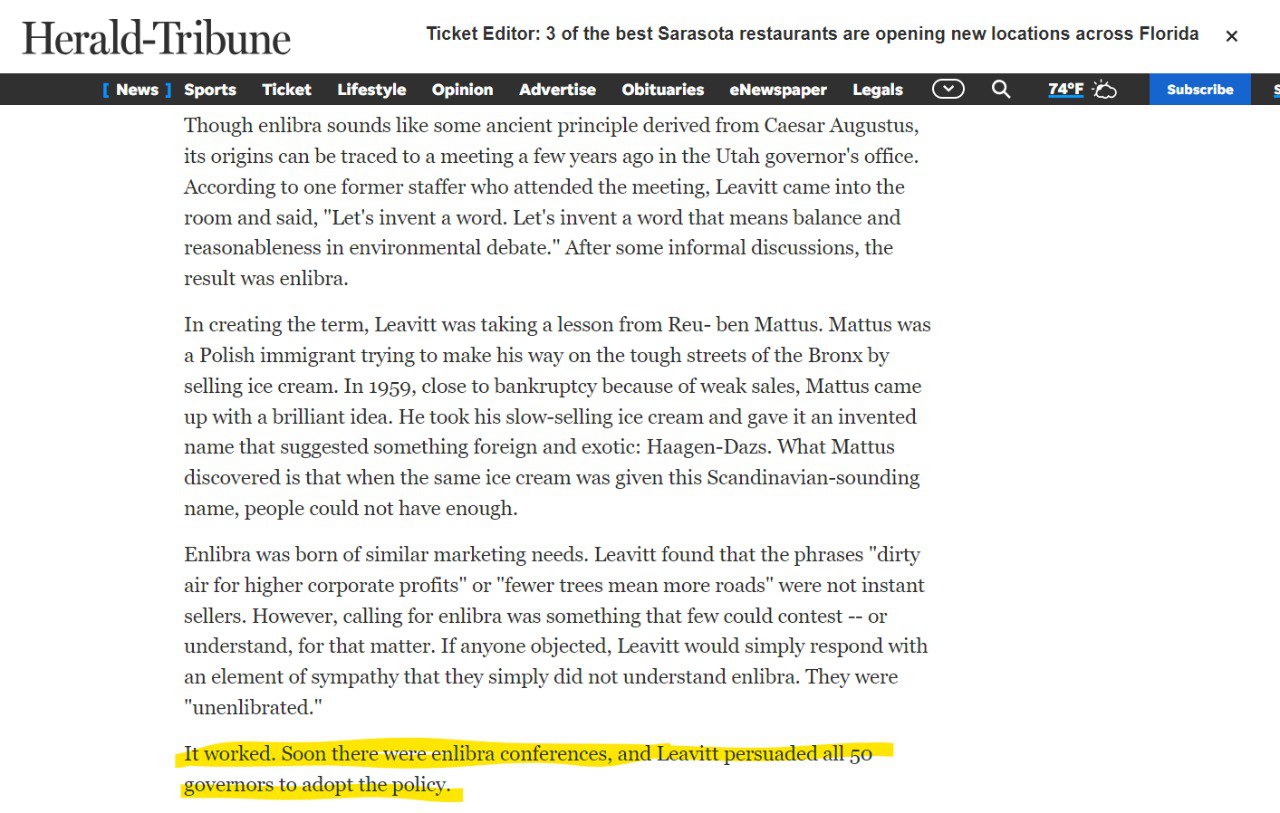
The quote below is greatly concerning when you understand their intentions. Enlibra is the national system and Envision Utah is the local. Thus, they have control at all levels.
“This western vision is a driving force behind Enlibra, the Western Governors Association’s new doctrine for environmental management in the region. The governors want less remote control and more local control over western resources. Enlibra outlines their push for strong local leadership to balance development and conservation goals, and resolve environmental conflicts. In fact, the first two principles of Enlibra are identical to the policy architecture promoted by Sabel, Fung, and Karkkainen.” Source: https://www.weber.edu/weberjournal/Journal_Archives/Archive_C1/Vol_17_2/MOelschlaegerEss.html
We genuinely tried to avoid being snarky, but honestly this is so frustrating we couldn’t help it. Why is giving the public ALL information so difficult? Why can’t all these organizations, groups, public private partnerships, NGOs tell the public the truth both good and bad? Once everyone has ALL the information, they can make the choice best for their neighborhood, city, county and state.
Why can’t all these organizations and groups stop manipulating language? Why are they calling drones “air mobility” or some other ridiculous name? Is it because the public is less likely to know what that is? Call things what they are, be up front. Otherwise, look disingenuous at best and nefarious at worst.
This will wrap up part 1, and yes this is just part 1. There is much more to go into here because the public has not been given access to or “allowed” to know about the REAL plans for the corridors and rewilding of North America.
Please let us know what you think. Do you think things have improved? Do you think states should have control over their land, or the federal government? Do you think public-private partnerships are helping or harming? Are they in line with a constitutional republic? Are they representative?
Please let us know what you think in the comments below and share with people you know to help share the information. Part 2 will start to focus on their “environmental plan.”

